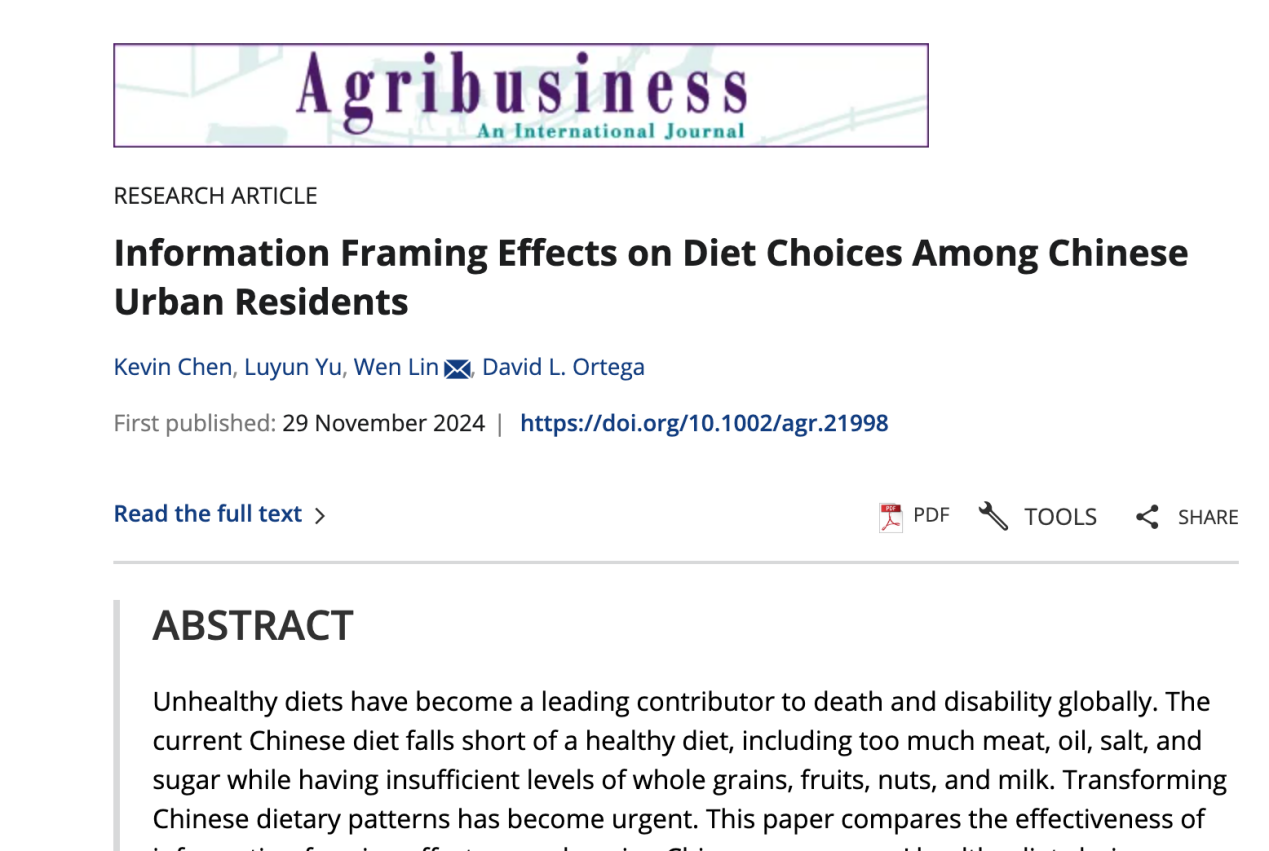近日,浙江大学中国农村发展研究院陈志钢教授、林雯研究员(通讯作者)、博士研究生余露芸以及密歇根州立大学农经系David Ortega教授的合作论文“Information Framing Effects on Diet Choices Among Chinese Urban Residents”在期刊Agribusiness: An International Journal在线发表。

全文链接:
https://onlinelibrary.wiley.com/doi/10.1002/agr.21998
文章概要:
不健康饮食已成为全球死亡和疾病负担的重要因素之一。近年来,随着中国城乡居民膳食水平的显著提升,温饱问题得到有效解决。然而,在新的发展阶段,城乡居民的食物消费面临着营养不均衡的新挑战,尤其表现在谷物消费过于精细、肉类消费过量,而水果、奶类等健康食物的摄入严重不足。这种膳食不均衡不仅对居民健康带来了不利影响,还加剧了环境压力。近年来,中国城乡居民超重和肥胖率快速上升,与饮食相关的慢性病发病率亦呈现上升趋势。此外,肉类消费的快速增长进一步加重了资源和环境的压力。因此,如何有效推动中国城市居民的“膳食革命”,成为亟需解决的紧迫问题。
本研究探讨了健康信息的框架效应,重点分析了信息内容、来源及呈现方式对中国消费者健康饮食选择的影响。通过在中国六个主要城市开展的在线离散选择实验,本文调查了3150名城市消费者在接收到不同类型信息干预后的膳食偏好变化。研究结果表明,负面框架的健康信息在提升消费者对健康饮食的重视程度方面,显著优于积极框架的健康信息。此外,来自社交名人的健康信息在引导消费者做出健康饮食选择方面的影响力,明显强于来源于科学专家的信息。然而,当健康信息通过社交媒体平台传播时,其对促进健康饮食选择的效果则显著减弱。上述研究发现为政策制定者及营养干预项目的设计者提供了实证依据,有助于在中国及其他发展中国家制定更为有效的饮食干预策略,推动居民健康饮食行为的转型。
英文摘要:
Unhealthy diets have become a leading contributor to death and disability globally. The current Chinese diet falls short of a healthy diet, including too much meat, oil, salt, and sugar while having insufficient levels of whole grains, fruits, nuts, and milk. Transforming Chinese dietary patterns has become urgent. This paper compares the effectiveness of information framing effects on enhancing Chinese consumers' healthy diet choices, varied by information content, source, and presentation. The survey is conducted across six Chinese cities, with a sample of 3150 urban consumers. Chinese consumers' healthy diet choices are measured using an online discrete choice experiment. Four different diet patterns were used to label each of the product alternatives in the experiment, which varied in taste and cost. Results reveal that compared to positive information; negatively framed healthy information is more effective in increasing Chinese consumers' valuations for healthy diets. Consumer valuation of a healthy whole diet is significantly enhanced when the information is from social celebrities, compared to information from a scientific source. Moreover, when health information is disclosed via social media, its effectiveness in promoting healthy diet choices is significantly reduced. Our findings have implications for designing and implementing nutrition policies and programs in China and other developing countries.


